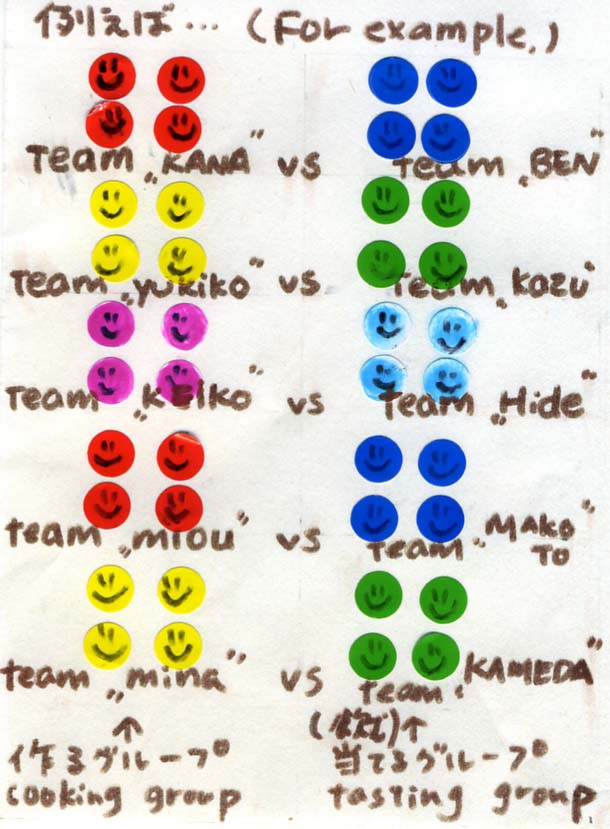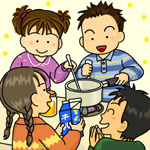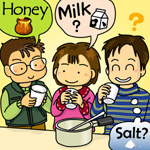まず、パート1では各国のお友達に登場してもらい、おばあちゃんから教えてもらった風邪の治し方を教えてもらいます。パート2は、実際の教室でその効用を発表しちゃおうというものです。さて、アナタの風邪にはどれが一番効くのでしょうか!?
In Part 1, our friends from around the world will tell us how we can make traditional cures for colds.
In Part 2, we'll go to class and see how effective these cures are. So, which one do you think will work the best?
|
■PART2
◆
パート1で紹介してもらった「風邪を治す方法」を、今度はみんなが実際に教室で発表してみましょう。
After you've tried the different cures for colds in Part 1, present your results to your class.
●家族の人に聞いてみよう
Ask your family
風邪になったら 家でおばあちゃんはどんなスープ(または飲み物)を作ってくれるかな?もし、家族の人が忙しかったら、各国のお友達が紹介してくれたパート1のスープ(または飲み物)を紹介してみよう!
What does your grandma give you when you catch a cold? Is it soup, or some kind of drink? If your family's busy, then try some of the recipes that our friends in Part 1 shared with us.
◆
"My grandma told me that ..."
「おばあちゃんの言うことにゃ・・・」
すでに動詞の過去形を勉強した上級者のみんなはこのセンテンスを使ってね(もちろん英語の方だよ)。
For those advanced students who have already studied the past tense, try using the sentence above.
◆
"This is my special drink. "「これが私のスペシャルドリンクです」
まだ動詞の過去形を勉強していなかったら、このセンテンスを使ってね。
For those who haven't studied the past tense yet, try using this sentence instead.
|
<授業の進め方> (Lesson Plan)

↑図で説明してみると・・・
(Click here! )
1) クラスを「作るグループ」と「飲むグループ」の半分に分ける
Divide the class into two groups: a cooking group and a tasting group.
2) 1で作ったグループを、さらにそれぞれ5つのグループに分ける (つまり、全部で10のグループができる)
Divide each group into five smaller groups.
3)2で作ったグループ内で、それぞれ対戦相手を決める
Each cooking group will compete against a tasting group so assign which group will compete with which.
※例えば、チーム「Kana 」4名(作るグループ)VSチーム「Ben」4名(飲むグループ)に。
For example, the four-member team "Kana" from the cooking group competes against the four-member team "Ben" from the tasting group.
<作るグループの人たち> (Cooking group)
二つのやり方があります。
There are two ways of playing this game:

|
| これで元気になるよ! |
パターン1
Game 1: 各自が作ったドリンクを持参する場合
( Each member of the cooking group should bring a home-made recipe for colds to school. )
1)グループ内でそのドリンクを試飲する
Each member of the cooking group should taste every recipe.
※みんなのドリンクを飲んだら、グループで作るドリンクを1種類決めるよ。一番おいしくて簡単に作れるものを選ぼう!
(Choose the one that the group likes the most and which is the easiest one to cook.)
2)作ってみよう
Let's try making it!
3)それぞれの「作るグループ」が作ったいろいろなドリンクがでそろう
Each group will come up with a different recipe.

|
| 次は何をいれるんだっけ? |
パターン2
Game 2
外国のお友達が紹介してくれたドリンクを作る場合
(The cooking groups can make a recipe from this site.)
1)グループのみんなで、一番おいしくて一番簡単に作れそうなものを選ぶ
Discuss the recipes with your team mates and decide which you think is the tastiest and easiest to make.
2) 作ってみよう
Let's try making it!
3)いろいろなドリンクができあがるよ
Each group will come up with a different recipe.
<ここからゲームがスタート!>
From here on Game 1 and 2 become the same.
1) 作り終わったら、「作るグループ」のみんなは、「飲むグループ(当てるグループ)」のお友達がいる教室へ戻ろう
After making the recipe, go back to class where the tasting group will be waiting.
3) いよいよ発表タイム!ジャジャーン !
Ta-dah! Time to guess the ingredients of each cure!

|
| へへへー 塩だったかな? |
4) 作るグループの人たちは、上で習ったセンテンスを使って発表しようね
Try to use today's sentence — "My grandma told me that ..." and "This is my special drink: ..."
5)当てるグループの人たちは、何が入っているか英語でいってみよう
The members of the tasting group now have to try and guess in English what the ingredients are of each recipe.
習った単語:野菜の名前や 飲み物の名前はいえるかな?
Do you remember the English words for drinks and vegetables?
例)牛乳(milk), はちみつ(honey), たまねぎ (onion)
※単語が分からなかったら、先生に聞いてみよう!
先生へ:生徒が野菜や飲み物の名前を聞いてくるかもしれないので、前もってでてくる単語を用意しておいて下さい。
6)
"Time's up!  時間になりました!
時間になりました! 作ったグループの人たちは正解を言おう。
そのドリンクの中身を見せながら、みんなの反応を楽しもう。
Time to reveal what the ingredients are. The cooking group should show each ingredient to the tasting group and see how they will react.
☆クラスのあと、自分が作ってきたドリンクのレシピを、日本語と英語で書いて配ってみよう。家でも作ってみてね。
After class, let's write out the recipes in Japanese and English and hand them round. Try them out at home.
<このレッスンの活用方法>
※発表のあと、なぜそのドリンク(飲み物)が効くのか調べる(宿題)。そして後日発表してもらう。
→ 他教科(この場合、家庭科)と関連づけたレッスンの展開へ。
Something to think about: After you've found out what went into each drink, try researching why it's so effective for treating colds. Present the results of your research to your class. It may have some relevance to your domestic science course.
☆★編集後記★☆
いかがでしたか?ひとくちに風邪を治すといっても、世界各地にいろいろな方法があるんですね。今回教室で試すという性質上ご紹介できませんでしたが、ヨーロッパでは風邪を引いたらよくホットワインを飲みます。これは、赤ワインをあたためて飲むといういたってシンプルなものですが、体のしんから温まります。また、今回ご紹介したポーランドの "Mleko Z Miodem"は、不眠症に効くことでも知られているそうです。
So what do you think?
Curing a cold may sound simple, but there are many different ways of going about it, depending on the country. These may range from the ordinary to the exotic. Because this site is targeted toward children, there was one remedy that I didn't think it was appropriate to mention. In Europe, people used to drink warm red wine to cure colds. This may sound simple, but it will really warm you from your head to your toes.
Now, "Mleko Z Miodem" from Poland will share a cure from insomnia with us?

|
また今回は、日本を含めた「世界各国編」ということでやってみましたが、「みんなの田舎編」としてやってみるのも面白いかもしれません。自分の生まれ故郷をよりよく知るきっかけになったり、都会に住んでいて
身近にお年寄りがいない場合、近くの老人ホームを訪ねるなどすれば、コミュニケーションをとるきっかけにもなると思います。今回のレッスンは、味覚を鍛え、いろいろな人と会話を交わし、お国事情を知るという、とても「欲張りなコース」です。
We tried two version for the game today, but there is also a third, in which children find recipes from rural Japan. The children will get to know more about their hometowns, and if there are no elderly people around them, or they live in a big city, they can go to a retirement home and speak with them, which would be great opportunity for practise communicating. Recently, you might have heard the term gastronomic education, and this game allows the children to train their tongues. Not only that, it helps children communicate more, it helps them learn more about other countires, and in that sense, it's a fairly extravagant course.
|
|







